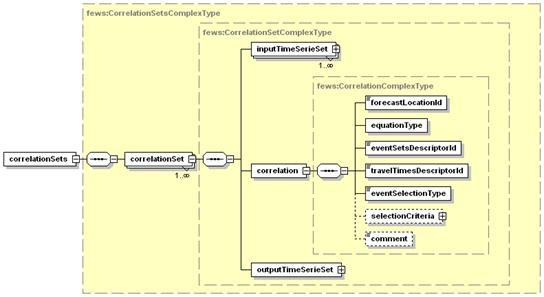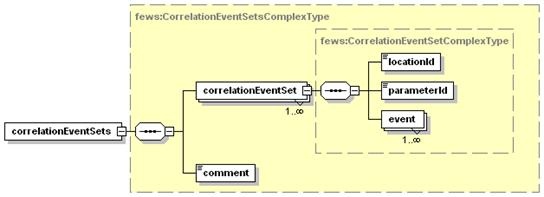The Correlation Module is used to estimate a level at a downstream location through correlation of historical levels and discharges at specific upstream locations. This utility is provided through an interactive interface available on the operator client as well as for running automatically using a fixed correlation in the Forecasting Shell Server. The module may employ data from historical events at different locations as available in the central database
The module can be used in two ways:
The correlation module uses two associated configuration items to establish correlations, these are the CorrelationEventSets and the TravelTimes.
When available as configuration on the file system, the name of the XML file for configuring an instance of the correlation module called for example Correlation_Severn_Forecast may be:
Correlation_Severn_Forecast 1.00 default.xml
Correlation_Severn_Forecast | File name for the Correlation_Severn_Forecast configuration. |
1.00 | Version number |
default | Flag to indicate the version is the default configuration (otherwise omitted). |

Figure 82 Elements of the correlationSets configuration
Root element for defining a correlation to be applied..
Time series set to be used as input for the correlation. This time series set can either be a complete hydrograph (e.g. equidistant time series). It may also be a non-equidistant series of peaks sampled using a transformation module defined previously in the workflow.
Time series set to be used as input for the correlation. Values are returned for the same time step as the input series.
Root element for the definition of a correlation
LocationId for the forecast location. This is the location to be defined in the output time series set.
Definition of the equation type to be applied in determining the correlation.
Attributes;









Figure 84 Elements for defining correlationEventSets
Optional comment for correlation event sets configuration. Used for reference purposes only.
Root element for defining set of events at a location to be used in establishing correlations.
LocationId for which events are defined
ParameterId for which events are defined.
Definition of events at the specified location for the specified parameter.
Attributes;
Since 2019.01 it is possible to define correlation events based on (multivalued) location attributes.
The advantage to this is the possibility to store the events in csv format
<?xml version="1.0" encoding="UTF-8"?>
<correlationEventSets xsi:schemaLocation="http://www.wldelft.nl/fews https://fewsdocs.deltares.nl/schemas/version1.0/correlationEventSets.xsd" xmlns:xsi="http://www.w3.org/2001/XMLSchema-instance"
xmlns="http://www.wldelft.nl/fews">
<timeZone>GMT</timeZone>
<correlationEventSet>
<locationSetId>MultiValuedAttributePeakHeights</locationSetId>
<eventIdAttributeId>EVENT_ID</eventIdAttributeId>
<eventParameterLocationAttributeId>PEAK_HEIGHT_PAR</eventParameterLocationAttributeId>
<eventTimeLocationAttributeId>PEAK_HEIGHT_TIME</eventTimeLocationAttributeId>
<eventValueLocationAttributeId>PEAK_HEIGHT_VALUE</eventValueLocationAttributeId>
</correlationEventSet>
</correlationEventSets>
|
<?xml version="1.0" encoding="UTF-8"?>
<locationSets xmlns="http://www.wldelft.nl/fews"
xmlns:xsi="http://www.w3.org/2001/XMLSchema-instance"
xsi:schemaLocation="http://www.wldelft.nl/fews https://fewsdocs.deltares.nl/schemas/version1.0/locationSets.xsd" version="1.1">
<locationSet id="MultiValuedAttributePeakHeights">
<csvFile>
<file>MultiValuedAttributePeakHeightsLocations.csv</file>
<geoDatum>WGS 1984</geoDatum>
<id>%ID%</id>
<name>%NAME%</name>
<x>%X%</x>
<y>%Y%</y>
<z>0</z>
<attributeFile>
<csvFile>MultiValuedAttributePeakHeightsLocationAttributes.csv</csvFile>
<id>%ID%</id>
<dateTimePattern>dd-MM-yyyy</dateTimePattern>
<attribute id="EVENT_ID">
<text>%PAR%%VALUE%%TIME%</text>
</attribute>
<attribute id="PEAK_HEIGHT_PAR">
<text>%PAR%</text>
</attribute>
<attribute id="PEAK_HEIGHT_TIME">
<dateTime>%TIME%</dateTime>
</attribute>
<attribute id="PEAK_HEIGHT_VALUE">
<number>%VALUE%</number>
</attribute>
</attributeFile>
</csvFile>
</locationSet>
</locationSets>
|
ID,PAR,VALUE,TIME,ACTIVE PH_locA,H.m,0.1,01-01-2001,true PH_locA,H.m,0.2,02-02-2002,false PH_locA,H.m,0.3,03-03-2003,true PH_locA,H.sim,0.4,04-04-2004,false PH_locA,H.sim,0.5,05-05-2005,true PH_locA,H.sim,0.6,06-06-2006,true PH_locB,H.m,1.1,11-10-2011,true PH_locB,H.m,1.2,12-10-2012,false PH_locB,H.m,1.3,13-10-2013,true PH_locB,H.m,1.4,14-10-2014,false PH_locB,H.sim,1.5,15-10-2015,true PH_locB,H.sim,1.6,16-10-2016,false PH_locB,H.sim,1.7,17-10-2017,false PH_locB,H.sim,1.8,18-10-2018,true |
This configuration file is related to the Correlation module, and is used to define the travel time between locations. These travel times may be used in matching events. The configuration file is in the TravelTimes (table or directory). Each configuration defined is referenced using a TravelTimes Id as defined in the Regional Configuration.

Figure 85 Elements of the TravelTimes configuration
Root element for defining a set of travel times. Multiple entries may exist.
LocationId of the downstream (forecast) location
Attributes;
Attributes;
Attributes;